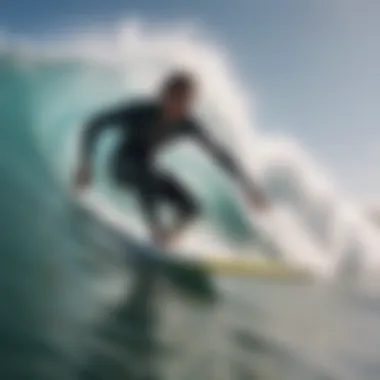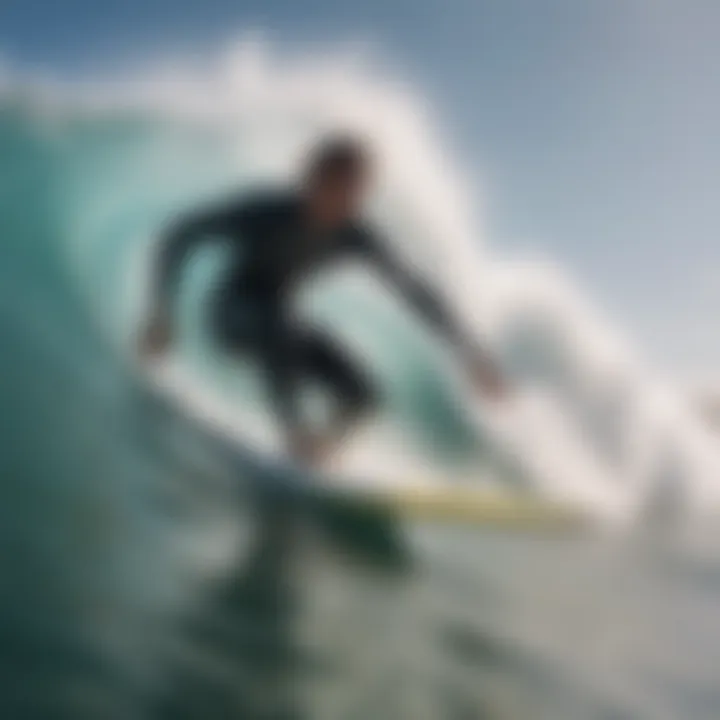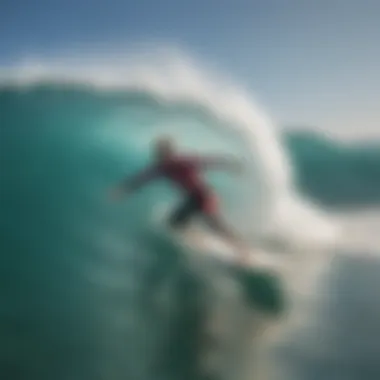Surf Athletes: Their Lives, Culture, and Impact


Intro
The life of surf athletes stretches beyond the waves and intricate maneuvers on water. For many, it embodies an existence characterized by a mixture of dedication, cultural richness, and an ongoing love affair with the ocean. Whether it’s a beginner anxiously paddling their first wave or a seasoned pro carving through the surf with finesse, every surfer carries with them a unique story and a passion that transcends competition. This section aims to introduce the different layers of their world, from the grueling training regimens they adhere to, to the mental frameworks that keep them grounded.
Surfing is more than just a sport; it's a lifestyle intertwined with nature. The adrenaline rush, the salty air, and the companionship found in the surfing community form a bond that runs deep. As we delve into specific aspects such as surfboard techniques and gear, the narrative will unfold to highlight how surf athletes contribute not only to their sport but also to social movements centered around sustainability. In essence, this exploration serves as a reminder that every wave ridden is a testament to the culture and commitment of those who embrace the surf lifestyle.
Surfboarding Techniques
Mastering surfing involves more than splashing around in the ocean; effective techniques are essential for both safety and skill development. It's a journey filled with hurdles and triumphs, and this section breaks down practical approaches for both novices and veterans.
Beginner Tips for Mastering the Basics
Starting off, newbies diving into surfing might find themselves overwhelmed by the sheer nature of the ocean. Here are some tips to set the stage for a solid foundation:
- Choosing the Right Board: For beginners, a wider, longer board like a soft-top longboard is advisable. This provides better stability as you learn to balance while paddling out and riding waves.
- Focus on Paddling: Strong paddling is key. It helps in catching waves. Work on your arm strokes to create a rhythmic motion.
- Pop-Up Techniques: Practice your pop-up on solid ground before hitting the water. Understanding body mechanics can make transitioning from lying to standing more fluid.
- Understanding the Ocean: Observing wave patterns. It’s imperative to grasp how tides and currents work. Observing surfers in action can also offer invaluable insights.
Grasping these fundamental skills lays the groundwork for a rewarding surfing experience.
Advanced Techniques for Seasoned Surfers
For those who've conquered the basics, entering the realm of advanced techniques is where the sport truly shines:
- Carving and The Cutback: Carving involves leaning into the turns while maintaining speed. The cutback allows surfers to return to the breaking part of the wave, prolonging their ride.
- Aerials and Tricks: Incorporating aerials into your repertoire requires strong board control and timing. Start small and gradually incorporate more complex tricks as confidence builds.
- Wave Selection: Knowing which waves to target can make or break your experience. Seasoned surfers learn to read waves to predict their behavior and identify the best moments to catch them.
Mastering these advanced techniques not only enhances the surfing experience but also deepens the connection with the ocean.
Surfboard Equipment
Just as athletes in other sports rely on specific gear, surf athletes find resonance in ensuring they have the best equipment, echoing the sentiment that what you ride on doesn't just influence performance but also speaks volumes about individual style.
Reviews of the Latest Surfboards on the Market
The market is teeming with options: from innovative technologies to eco-friendly choices. Here’s a glance at some noteworthy boards:
- Firewire Surfboards: Known for their sustainable materials and durability. Many pro surfers endorse them.
- Channel Islands Surfboards: Offers a wide range of performance boards suitable for all levels, boasting a solid reputation across the surfing community.
These brands highlight a shift towards sustainability, echoing the emerging desire for environmentally-conscious choices within surf culture.
Essential Gear for Every Surfboarder
Beyond just boards, having the right gear enhances the overall experience:
- Wetsuits: Essential for colder waters. A properly fitted wetsuit enhances mobility and keeps you warm.
- Leashes: Often overlooked, a good leash keeps your board close after a wipeout, ensuring safety and preventing collisions.
- Surf Wax: A necessary component for grip. Adapt the wax type to specific water temperatures for optimal performance.
This equipment ensures that athletes stay prepared for whatever the ocean throws at them.
Surfing encompasses not just the ride, but the lifestyle choices surfers make, influencing everything from fashion to environmental activism.
The Identity of a Surf Athlete
The identity of a surf athlete goes beyond just someone who rides waves; it's a complex blend of culture, community, and physical prowess. This article aims to untangle the rich tapestry that defines surf athletes, examining their training, mindset, and the cultural context that shapes their experience. Acknowledging this identity allows us to understand the profound impact surf athletes have on both sport and society.
Defining Surf Athlete
At its core, the term "surf athlete" encompasses not just physical skills but also a particular mindset and lifestyle. These individuals are athletes who commit to rigorous training, often spending hours in the water or in the gym, fine-tuning their strength, endurance, and flexibility. They are driven by a passion for the ocean and a desire to perform at their best.
Surf athletes participate in various competitions, from local contests to global events like the World Surf League. Their dedication is palpable; they are often seen practicing in various conditions to develop adaptability. The community aspect adds a layer to the definition. Surf athletes often mean being part of a vibrant subculture that fosters camaraderie and shared values rooted in respect for the environment. In this sense, being a surf athlete is about belonging, learning, and evolving alongside others who share the same fervor.
Cultural Context of Surfing
Surfing, as a sport and cultural phenomenon, holds a significant place in various societies, each infusing its unique flavor into the practice. In places like Hawaii, surfing is deeply interwoven with history and spirituality. The ancient Hawaiians regarded the ocean not just as a source of nourishment but also as a sacred space. This perspective shapes how current surf athletes view their sport; there’s a reverence for the ocean that transcends mere competition.
In contrast, places like California have contributed a different narrative. Freestyle expressions and rebellious attitudes during the 1960s helped carve out surfing as a mainstream culture. Here, surf athletes became icons, seen not only as skilled practitioners but also as part of a lifestyle that defied societal norms.
The modern surf scene reflects these roots while evolving with influences from technology and media. Today’s surf athletes leverage social media platforms, showcasing their skills while promoting awareness of environmental issues. This merging of athleticism and advocacy signifies a shift in consciousness where athletes are not merely competitors but also ambassadors for sustainability in surfing.
"Surfing is not just a sport. It’s a state of mind, an identity rooted in the waves and the community it fosters."
Understanding the cultural context of surfing is vital for appreciating the identity of surf athletes. It assists in recognizing the values that drive them—values that are often shared and passed down through generations, contributing to a vibrant community that continues to grow and adapt.
Physical Demands of Surfing
Surfing is not just a sport; it’s an intricate dance with nature, requiring unique physical attributes and rigorous training. The physical demands of surfing encompass a blend of strength, endurance, balance, and flexibility that go hand-in-hand with the artistry of riding waves. Understanding these elements is fundamental for anyone passionate about the surf lifestyle, whether they're seasoned riders or those new to the waves. The nuanced requirements of the sport highlight why surf athletes are often viewed as some of the fittest individuals in the athletic arena.
Beyond just the thrill of gliding on water, the physiological skills needed to execute a flawless ride can’t be overlooked. It’s not only about riding the wave but also about mastering one’s body against powerful forces. Let's dive deeper into two pivotal aspects: strength and endurance, followed by balance and flexibility.
Strength and Endurance Training
When we talk about strength in surfing, we’re pointing to the blend of core stability, leg power, and upper body strength. These components are crucial for paddling into waves, sustaining balance, and performing maneuvers. The act of paddling itself requires significant upper body strength, as surf athletes often find themselves battling against the currents, propelling forward while maintaining control.
To enhance strength, many surf athletes engage in functional training that mimics the movements made on the board. Exercises such as push-ups, pull-ups, and core workouts play an integral role. Resistance training, especially movements that target the shoulders and back, is paramount.
Endurance also takes center stage, allowing surfers to keep their energy levels high throughout long sessions. Building cardiovascular fitness is essential. Activities like running or cycling can improve stamina, promoting a better performance when it counts. Endurance also helps in recovering quickly from physical exertion, meaning surf athletes can paddle back out into the action without missing a beat.
"A solid foundation of strength and endurance leads to confidence; confidence opens doors to new surfing challenges."
Balance and Flexibility
Balance is the cornerstone of good surfing. Surfers are constantly adjusting their center of gravity as they ride waves, and this requires not only coordination but also a finely-tuned sense of balance. Surf athletes often incorporate balance training into their routine, utilizing techniques such as standing on balance boards or practicing yoga, which has become increasingly popular among surfers.


Alongside balance, flexibility is critical for optimizing performance on the waves. Surfing demands a full range of motion: reaching for the paddle, maneuvering into different stances on the board, or twisting to carve through waves. Greater flexibility not only aids in executing these movements but can also prevent injuries that may arise from tight muscles.
Incorporating stretching routines and yoga into their regimens allows surf athletes to improve their flexibility, enhancing their overall performance. This combination of stability and flexibility cannot be overstated, as it enables surfers to adapt dynamically to changing wave conditions.
The symbiotic relationship between strength, endurance, balance, and flexibility defines the physical demands of surfing. By honing these qualities, surf athletes don’t just ride waves; they thrive in the ocean’s unpredictable ballet. This intricate training ensures they can rise above the challenges, both on the water and in the context of their personal athletic journeys.
Mental Aspects of Surfing
Surfing isn't just about catching waves; it's also a mental game that requires focus, resilience, and emotional stability. The mental aspects of surfing play a crucial role in an athlete's performance, affecting everything from their technique to their enjoyment of the sport. Cultivating a strong mental framework can lead to improved consistency in the water and a deeper connection to the ocean and its rhythms.
Focus and Mental Preparation
The need for focus in surfing is paramount. The ocean is an ever-changing environment, and decisions must be made swiftly. Having a clear mind helps athletes read waves effectively, forecast shifts in conditions, and position themselves for optimal rides. Mental preparation integrates visualization techniques, where surfers imagine themselves successfully navigating challenging waves. This practice not only builds confidence but also trains the mind to remain calm during high-pressure situations.
A well-prepared mindset aids in performance. Surfers often develop pre-surf routines that help them get into the right headspace. Whether it’s listening to music, practicing breathing exercises, or going through a series of stretches, these small rituals can significantly sharpen focus.
"Surfing is 90% mental. You can have the best equipment, but if your head’s not in it, you're not going to succeed."
Overcoming Fear and Anxiety
Fear and anxiety are common hurdles for surfers. The thought of paddling out into powerful surf can be intimidating. Successfully tackling these emotions is essential for progression in the sport.
Surfers use various strategies to manage anxiety and fear. Cognitive Behavioral Therapy (CBT) techniques are increasingly popular, allowing athletes to reframe negative thoughts into more rational, performance-enhancing beliefs. It involves identifying fears, understanding their triggers, and gradually working through them in a controlled setting.
Moreover, positive reinforcement from peers and mentors plays a vital role in building courage. By sharing experiences, athletes can lessen the stigma surrounding fear and support one another, fostering a community of understanding.
Additionally, engaging in mindfulness practices, like meditation, allows surfers to increase their awareness and stay grounded during moments of stress. This self-awareness fosters better responses to the fear that may arise from wipeouts or challenging surf conditions.
Understanding and addressing the mental components of surfing not only leads to better performance but also to a richer, more fulfilling experience within the sport.
Equipment and Innovation
When we speak of surfing, many might visualize coastal bliss and harmonious waves, yet the unsung heroes often arise from the materials and technologies that buoy the sport to new heights. Equipment and innovation play crucial roles in shaping not just the performance of surf athletes but also how they engage with their environment and their sport. As surfing progresses and the waves evolve, so too does the necessity for superior gear that amplifies mobility, comfort, and protection on the water.
Surfboard Technology
At the heart of every surf athlete's experience lies the surfboard, a simple but sophisticated tool that can define a surfer's connection with the waves. Modern surfboards have transitioned far beyond the classic wooden crafts of the past. Today, materials such as epoxy and foam allow for lighter boards that enhance speed and performance. The design of surfboards is another arena of innovation. Shortboards, longboards, fish, and hybrid shapes all cater to diverse surfing styles and environments, enabling athletes to ride in a multitude of conditions.
- Performance Benefits: Lighter boards lead to quicker maneuvers and better control, essential for tricks and sharp turns.
- Adaptability: Different board shapes allow surfers to adapt to varied wave heights and conditions, making it possible to thrive whether riding small swells or hefty breaks.
- Environmental Considerations: A movement towards eco-friendly materials is rising. Factories that produce surfboards, like those making boards from recycled materials, showcase the possibility of reducing the sport's environmental footprint.
Notably, brands such as Firewire Surfboards are at the forefront of integrating technology with sustainability, proving that innovation can coexist with ecological consciousness.
"A surfboard is not merely an object to ride on; it's the conduit between the athlete and the ocean, often dictating the experience of every swell."
Wetsuits and Performance Gear
Wetsuits are another staple in a surfer's arsenal. They serve the dual purpose of protection against the cold and the ocean's elements, while also offering support and flexibility. Materials such as neoprene have undergone substantial advancements, becoming thinner yet warmer, allowing athletes to navigate chilly waters without hinbering their agility.
- Temperature Regulation: Wetsuits tailored for specific water temperatures enhance comfort significantly, reducing fatigue and promoting longer sessions in the surf.
- Mobility and Fit: Tight-fitting designs prevent water from flushing in and out, making for a streamlined surfing experience. Updated seams and panel designs ensure greater flexibility without compromising durability.
- Technology Integration: Emerging products are now incorporating features such as antimicrobial coatings to prevent odor, or thermal linings to trap heat more efficiently.
Training and Competition
Training and competition are not just integral parts of a surf athlete’s life; they serve as the backbone that supports their passion for the ocean. The ocean can unpredictably change its mood, with waves rising and falling, requiring athletes to be always prepared physically and mentally. Regular training sessions build the necessary strength, endurance, and skill set needed to ride waves effectively. This preparation goes beyond physical ability to also include mental readiness that enhances performance during competitions.
Daily Routines of Surf Athletes
A typical day in the life of a surf athlete is often packed with rigorous activities focused on honing their craft.
Morning Sessions
Most surf athletes prefer to catch the early morning waves. Early mornings provide favorable water conditions, and athletes often feel invigorated, ready to tackle the day. These sessions might include:
- Warm-up exercises to loosen the body.
- Endurance paddling to build shoulder and back strength necessary for long sessions in the water.
- Wave riding practice, focusing on technique, balance, and speed.
Nutrition and Recovery
After a long surf session, recovery becomes paramount. Nutrition is addressed with a focus on replenishing energy levels. Athletes tend to consume high protein, complex carbs, and vitamins from fruits, fueling their bodies for the next round. Yoga, stretching, or meditation can also play a role in recovery, allowing both body and mind some down time.
Afternoon Routine
Post-lunch routines may vary, but many athletes spend afternoons:
- Gym workouts focusing on strength training, incorporating resistance exercises to boost overall fitness.
- Surf theory sessions, where they study videos of their performance and analyze techniques or learn to read wave patterns more effectively.
- Another surf session, particularly if conditions are promising.
Mental Strategies in Competition
As surf athletes prepare for competitions, maintaining a sharp mental edge is just as important as physical prowess.
Focus is key; athletes deploy various strategies to keep their minds clear:
- Visualization Techniques: Many athletes utilize this strategy to picture themselves performing well before hitting the water. By imagining successful rides and maneuvers, they instill confidence.
- Breathing Exercises: Controlled breathing techniques help maintain composure, reduce anxiety, and enhance focus during high-pressure moments.
- Positive Affirmations: Repeating empowering phrases reminds athletes of their skills and capabilities, bolstering self-esteem before a competition.
To summarize, the regimen of surf athletes is far more complex than just the act of surfing itself. Every moment spent training prepares them not just to ride waves but also to tackle the unpredictable nature of the sport and the ocean. Their daily routines are a blend of physical and mental exercises designed to enhance their performance while ensuring sustainability and personal growth.
"It’s more than just riding waves; it’s about mastering every aspect of the sport—mind, body, and spirit."
Through diligent preparation, athletes aim to perform well in competitions, keeping their spirits high. The evolving sport of surfing demands that they adapt and grow continuously, ensuring their passions thrive in harmony with resilience and tenacity.
Surfing and Environmental Consciousness
Surfing is not just a sport; it's a connection to nature that can raise awareness about environmental issues. The ocean, with its waves and tides, plays a vital role in the lives of surf athletes. Hence, their influence in advocating for marine conservation has become increasingly significant. As these athletes ride the waves, they also navigate complex conversations surrounding sustainability and environmental consciousness, championing initiatives that protect the world's waterways.
Sustainable Surf Practices
The surfing community has a rich tradition of respecting the environment. Sustainable surf practices encompass various elements aimed at minimizing the environmental impact of the sport. Here are some notable practices:


- Eco-Friendly Surfboards: Manufacturers are progressively shifting towards sustainable materials. Boards crafted from recycled polystyrene, biodegradable resins, and natural fiber composites reduce harmful waste.
- Green Wetsuits: Companies like Patagonia are leading the way, producing wetsuits from natural rubber and recycled plastics, lessening the reliance on petroleum-based products.
- Beach Cleanups: Many surf competitions incorporate beach cleanup events, rallying communities to remove plastic and other debris that threaten marine life.
"The best surfer out there is the one having the most fun" echoes a sentiment that every wave ridden should come with a responsibility toward the environment.
Impact of Surfing on Marine Environments
Surfing can have profound effects on marine ecosystems, depending on how surfers engage with their surroundings. Here are key considerations:
- Ocean Health Awareness: Surfers often witness the effects of pollution first-hand, prompting many to become vocal advocates for ocean health. Their unique perspectives allow them to notice changes in water quality and marine life.
- Sedimentation and Habitat Disruption: Surfing spots can be harmed by overdevelopment and heavy foot traffic, which can lead to sand erosion and habitat loss. This reinforces the need for responsible surf tourism that prioritizes conservation.
- Advocacy for Marine Protected Areas: Many surf athletes are involved in campaigns to establish marine protected areas (MPAs), which are essential for preserving biodiversity and restoring fish populations.
By promoting awareness and healthy practices, surf athletes are not just riders of the waves but also stewards of the ocean, championing its wellbeing alongside their thrilling experiences. This call to action is critical as we move forward, blending athleticism with ecological responsibility.
Social Dynamics in Surfing
The world of surfing is more than just riding the waves; it's intertwined with social dynamics that shape behaviors, relationships, and communities. Understanding these dynamics is crucial for comprehending how surf athletes navigate their lives both in and out of the water. From the camaraderie shared among surfers to the mentorship that fosters growth, the social fabric of surfing plays a fundamental role in the identities of these athletes.
The Community of Surf Athletes
The community surrounding surf athletes is both unique and vital. It's a mixture of friendship, competition, and mutual respect that often blurs the lines between rivalry and support. When surfers hit the waves, they're not just pursuing personal glory but also seeking connection with others who share their passion.
- Shared Experiences: Surfing offers shared experiences that create bonds. Whether it's the thrill of catching a massive wave or the collective frustration of waiting for the right swell, these moments forge a sense of belonging. Surf contests can fuel both competition and camaraderie, highlighting the dual nature of this sport.
- Inclusivity: Surfers come from various backgrounds, uniting under their love for the ocean. From youngsters just starting out to seasoned athletes, the community welcomes all. This diversity enriches the culture, enabling surfers to learn from each other's stories, struggles, and strategies.
"Surfing is not just a sport; it's a way of life. The people we meet and the relationships we build are what makes it incredible."
— Anonymous surfer
- Localism: While the community is largely welcoming, localism can create tensions. Longtime locals sometimes feel protective of their favorite breaks, leading to complicated dynamics with newcomers. This can offer challenges but also cultivates a sense of loyalty toward home spots, breeding respect for the waves and the community.
The social landscape within the surfing community also includes social media platforms, where surfers share their achievements, struggles, and thoughts on sustainability practices. These arenas help amplify community voices and foster connections beyond geographical boundaries.
Mentorship and Coaching in Surf Culture
Mentorship in the surfing world is often informal, yet it carries significant importance. More experienced surfers frequently take novices under their wings, offering invaluable lessons both on and off the water.
- Skill Development: In surfing, mentorship can revolve around technique, providing new surfers with insights into posture, balance, and timing. A seasoned surfer saying, "You gotta feel the wave under your board," speaks volumes to someone just learning.
- Cultural Guidance: Mentorship transcends physical training. It encompasses the cultural aspects of surfing, communicating values such as respect for the ocean, environmental stewardship, and the spirit of surfing. Veterans pass down traditions and unwritten rules that define surf culture.
- Personal Growth: Alongside technical skills, mentorship promotes personal growth. Guidance can help young athletes navigate challenges, enhancing their resilience in competitive contexts or during tough personal times. A good mentor can be pivotal in fostering a surfer's confidence, reminding them that persistence pays off.
- Fostering Future Generations: The cycle of mentorship ensures the longevity of the surf community. As established surfers share their wisdom, they invest in the next generation, creating a bridge that sustains the culture. Grassroots programs often emerge, encouraging youth to engage in surfing, thereby cultivating future advocates for the sport and environment.
In summary, the social dynamics within the surfing community are intricate and significant. They cultivate relationships essential for personal and cultural growth. Through mentorship, surfers not only develop their skills but also deepen their commitment to the core values of the sport and the environment.
The Global Surf Scene
The realm of surfing extends well beyond the shores of local beaches; it embodies a vibrant global tapestry that unites diverse cultures and communities. Although surfing began as a traditional practice in Polynesia, it has grown into a worldwide phenomenon, drawing athletes from every corner of the globe. This section highlights the significance of this global scene and its impact on surf athletes' identities and opportunities.
The global surf scene creates an arena for competition, fraternity, and celebration of talents, fostering networks among surf athletes. Competitions—ranging from local hangouts to global championships—serve as milestones for surfers. These events not only showcase their skills but also contribute toward their professional growth. The ability to compete at various levels offers exposure and can open doors to sponsorships and collaborations. Additionally, participating in these competitions enhances the athletes' standing in the surf community.
"The waves don’t favor anyone; they belong to those who dare to ride them."
Surfing has transformed from a niche hobby into a mainstream sport, largely attributed to its growing global appeal. As more countries invest in infrastructure and training facilities, we see a rising number of competitive surfers from nations that historically lacked surf cultures. Countries like Japan, Brazil, and South Africa have developed their surf scenes, producing talented athletes who challenge the traditional powerhouses like the USA and Australia.
Key Surf Competitions Worldwide
The landscape of surf competitions is expansive, with various events catering to different skill levels and styles. Here are some pivotal competitions that hold considerable importance in the surfing world:
- World Surf League (WSL) Championship Tour: The apex of competitive surfing, featuring the best surfers on the planet.
- MSS (Masters Surfing Series): Celebrating older participants, showcasing their talent and passion for surfing.
- Dawn Patrol Events: Localized, community-focused surf competitions that encourage participation from all skill levels.
These competitions not only determine rankings but also enhance camaraderie among surfers. They allow athletes to exchange stories, techniques, and strategies, which in turn strengthens the collective knowledge of surfing. Moreover, the WSL and similar organizations have been instrumental in promoting environmental sustainability, further closing the gap between sport and advocacy.
Emerging Surf Destinations
With the rise of global surf tourism, several areas that were once off the radar have emerged as prime spots for surf athletes. These destinations not only offer pristine waves but also culturally rich experiences. Some noteworthy locations include:
- Taghazout, Morocco: Known for its consistent waves and stunning landscapes, this coastal village is quickly becoming a favorite among surfers.
- Sumbawa, Indonesia: Offering world-class surfing conditions and relatively uncrowded breaks, Sumbawa is a gem for those seeking waves and adventure.
- Punta de Lobos, Chile: Famous for its powerful swells, this destination attracts surf athletes looking for a challenge amidst breathtaking scenery.
Emerging destinations provide surfers with the chance to explore new cultures while refining their skills. Each wave presents unique lessons, pushing the boundaries of their surfing capacities. In turn, surf athletes act as ambassadors of their sport, spreading awareness and appreciation for surfing across different places.
Media Representation of Surf Athletes
The portrayal of surf athletes in various media forms holds immense importance in shaping public perceptions and cultural narratives surrounding surfing. This section will delve deeper into how these representations can highlight the athletes’ skills, contributions to surf culture, and their roles as advocates for both the environment and social justice. Through understanding media representation, one can appreciate how these athletes influence the sport's popularity and the broader cultural landscape.
Film and Documentaries
Films and documentaries about surfing are not just entertainment; they provide a canvas for surf athletes to showcase their passion and prowess. Storytelling through visual media has played a significant role in defining surfing culture globally. For instance, iconic surf films like "The Endless Summer" have not only chronicled the art of surfing but have also influenced generations of surfers by presenting a lifestyle that transcends borders.
These documentaries often highlight the dedication and challenges faced by surf athletes, bringing their stories to life. A notable recent example is the documentary "Momentum Generation," which profiles the rise of a group of young surfers who transformed the sport in the 1990s. Analyzing these films can reveal how they shaped both the narratives around surf athletes and the public’s understanding of the intricacies of competitive surfing.
Moreover, there is an increasing trend towards sustainability in these narratives. Documentaries are starting to focus on the environmental challenges surfers face, thus aligning with a broader movement toward ecological consciousness in the surf community. This dual approach leaves viewers not only entertained but also informed.
Social Media Influence
Social media has revolutionized how surf athletes connect with fans, fellow surfers, and brands. Platforms like Instagram and TikTok allow athletes to showcase their skills, lifestyles, and philosophies in real-time, offering an unfiltered glimpse into their lives. This shift has enabled surf athletes to cultivate a strong personal brand, an element critical to their visibility and marketability.
The influence of social media is profound:
- Direct Engagement: Athletes can interact directly with their audiences, fostering a sense of community.
- Highlighting Diversity: Social media has helped elevate diverse voices in the sport, showcasing surfers from various backgrounds and breaking down stereotypes.
- Advocacy Tools: Surf athletes can leverage their platforms to raise awareness about environmental issues, promoting initiatives like beach clean-ups or campaigns against ocean plastic pollution.
"Social media has empowered us, giving us a voice beyond the waves and allowing us to fight for causes we believe in," says professional surfer Bethany Hamilton, highlighting the powerful role social media plays.
Women's Influence in Surfing
The involvement of women in surfing has evolved significantly over the years, marking a vital chapter in the lore of surf culture. Understanding their influence goes beyond just recognizing individual athletes or events; it's about acknowledging the broader implications for the sport and society. Women surf athletes have made waves, not just on the water, but also in the domains of culture, fashion, and environmental advocacy. Their contributions can shift perceptions, challenge norms, and open new doors for future generations.
Trailblazing Female Surfers


When putting a spotlight on the originators of women’s surfing, a few names soar above the rest. Take Bethany Hamilton for instance—known for her exceptional talent and inspiring comeback after a shark attack. She is a testament to resilience and determination. Another bright star in the surfing panorama is Carissa Moore, who has not only won world championships but has also become an advocate for young female surfers, promoting inclusivity in the sport and emphasizing the importance of self-expression.
These women represent just a fraction of the trailblazers in this sport. In various parts of the globe, female surfers are rising to the occasion, breaking barriers often related to gender and cultural expectations.
"Every wave I ride is a reminder that the ocean is a place where anyone can find freedom, no matter who you are."
— Carissa Moore
In regions like Hawaii, Costa Rica, and Australia, local female surfers have been spearheading their own movements, often organizing competitions specifically designed for women. These events help raise visibility and provide girls with more opportunities to engage in surfing. Through social media platforms, these athletes share their journeys, inspire one another, and create a supportive community that extends beyond physical barriers.
Changing Perceptions and Opportunities
The shifting tides of perceptions concerning women in surfing have led to expanding opportunities. Surge in media coverage of female surfers has brought attention not only to their athletic abilities but to their roles as significant influencers in the surf culture. Today, brands like Roxy and Billabong sponsor female athletes, thereby signaling an industry willing to invest in women.
Different surfing events are now prioritizing gender equality. Competitions like the WSL Women’s Championship Tour showcase female athletes on a grand scale, displaying their skills and attracting larger audiences. This is more than a step forward; it’s a leap toward parity in sport, helping to dismantle outdated stereotypes that women often face.
Furthermore, the embrace of social media has opened yet another avenue. Female surfers, through platforms like Instagram and YouTube, are gaining prominence and becoming role models to young girls worldwide. With hashtags like #WomenWhoSurf and #GirlSurfers, these platforms mold a narrative that celebrates female empowerment in surfing.
The growth of programs designed to encourage young girls to surf is another positive outcome. Surf camps aimed at females are rising in popularity, fostering confidence, camaraderie, and skills development. With increased exposure and support, the next generation of female surfers can approach the sport with formidable ambition and confidence, knowing they're part of a progressive legacy.
Women in surfing remain catalysts for broader change, not just within their sport but across societal constructs. Their impact signals an increase in acknowledgement that capable, dedicated athletes emerge from all walks of life, challenging conventions and shaping future perceptions.
Future Trends in Surfing
Surfing, at its core, is not just about riding waves; it's an evolving culture being shaped by innovation and shifting attitudes. Understanding future trends in surfing is crucial for athletes, enthusiasts, and the wider community. As surfers face increasing challenges from climate change, technological advancements, and cultural shifts, these trends help illustrate the trajectory of the sport.
Among the glimmering benefits of recognizing these trends are better training methods, heightened sustainability efforts, and a more inclusive surfing community. Ultimately, it equips surfers to not only adapt but thrive in a changing environment.
Technological Advancements
The integration of technology into surfing has taken off in more ways than one. Advanced materials are now being used in surfboards, enhancing their performance, weight, and durability. For example, surfboards made with carbon fiber or epoxy resins are replacing traditional fiberglass, providing lighter and stronger alternatives. The environmental impact of these materials is also a point of consideration, with many manufacturers looking to balance performance with eco-friendliness.
Additionally, data analytics has entered the surf scene. Athletes can now leverage apps and devices that track their performance metrics, measuring everything from speed to the length of rides. With this information, surfers can tweak their techniques — analogous to how athletes in other sports analyze game footage.
"The best surfers are those who can adapt and innovate, constantly improving both their skills and gear."
On a more technical level, surf forecasting technology has become a game-changer. Platforms that use sophisticated algorithms to predict swell patterns give surfers a better shot at hitting the best waves. Knowing when and where to hit the ocean not only maximizes enjoyment but also minimizes the risk of overcrowding in popular spots.
Evolving Surf Culture
Surfing culture has witnessed a seismic shift in recent years, driven partly by the quest for inclusivity and diversity within the sport. The days of the lone surfer conquering the waves are fading. Now, communities are encouraging individuals from all backgrounds to take up surfing, thus enriching its narrative and expanding its reach.
Women's participation in surfing is on the rise, and with that comes a greater emphasis on representation. Surf athletes such as Carissa Moore and Stephanie Gilmore have inspired a younger generation, reshaping the perception of who can be a surfer. This shift is reflected in media portrayals and competition formats, showcasing an increasing number of female surfers in high-profile events.
Moreover, as surfers become increasingly aware of their environmental impact, there's a notable push towards sustainable practices. This involves using eco-friendly materials for surfboards and wetsuits, prioritizing second-hand gear, or even participating in beach cleanups to preserve the oceans they love to ride.
In addition, the way surfers connect with each other is evolving. Social media platforms like Instagram and YouTube have become vital in promoting surf culture, allowing athletes to share their experiences and skills while attracting new fans to the world of surfing. This also opens doors for grassroots movements aimed at enhancing safety and environmental stewardship within the sport.
In summary, the future of surfing is a mosaic of technological innovations and cultural shifts. By understanding and adapting to these changes, surf athletes are not only ensuring their longevity in the sport but also paving the way for a more dynamic and inclusive surfing community.
Challenges Faced by Surf Athletes
Understanding the challenges surf athletes endure is crucial in grasping their dedication and resilience. The peculiarities of surfing—where natural forces dictate performance—demand more than just skill and training. Surf athletes face hurdles ranging from physical injuries to navigating the tumultuous nature of competition, which can be mentally taxing.
Surfers often push their bodies to extremes, given the sport's inherent risks and high physical demands. This section will dive into the common injuries these athletes encounter and the strategies they employ to recover. Additionally, we'll explore how the competitive atmosphere can complicate personal growth, forcing athletes to strike a delicate balance between striving for excellence while nurturing their well-being.
Injury and Recovery
Injuries are an unfortunate but frequent aspect of a surf athlete's life. It isn't just about wiping out on a wave; the repetitive strain on muscles and joints can lead to severe complications. Common injuries include:
- Shoulder dislocations: This can happen during intense paddling or falling awkwardly.
- Knee injuries: The pressure on the knees from turning and landing can lead to various issues.
- Wrist sprains: Falling on outstretched hands often results in sprains or fractures.
Athletes must navigate these physical setbacks with care. Recovery isn't merely about resting; it involves a well-structured rehabilitation plan tailored to the injury's nature. Participating in physiotherapy sessions to strengthen surrounding muscles and practicing patience can accelerate the healing process. Meanwhile, some athletes utilize alternative therapies, such as acupuncture or yoga, which are believed to enhance recovery.
"Injuries can be a blessing in disguise for surf athletes. They often push us to find new strength and skills we didn’t know we had."
Balancing the Competitive Spirit with Personal Growth
For many surf athletes, competition can become a double-edged sword. While it drives performance and fosters skill development, it can also challenge an athlete's emotional well-being. Striving for victory can ignite passion, yet it might cloud the motivations that brought them to the water in the first place.
To remain grounded, athletes often engage in workshops or mentorship programs that emphasize mental well-being alongside competition. Additionally, techniques like visualization can aid in promoting a positive mindset. It reminds them why they fell in love with surfing—it's not solely about winning medals but enjoying the thrill of riding waves. The appeal of communal support within surf culture helps, too, as many athletes relate their stories and learn from one another.
Through this understanding, athletes find themselves not just as competitors but evolved individuals on a journey of continuous growth and self-discovery, harmonizing their competitive spirit with personal development.
Advocacy and Activism
Advocacy and activism hold immense significance within the surfing community, painting a vivid picture of how surf athletes not just ride the waves but also challenge the currents of social and environmental concerns. The world of surfing has gradually evolved to go beyond the realm of competition and leisure; it is now recognized as a platform for advocating crucial issues that affect our oceans and communities. This section explores how surf athletes embody these values, aligning their passions with a commitment to influence positive change.
Surf Athletes as Environmental Advocates
The ocean serves as both a playground and a sanctuary for surf athletes, making their connection to environmental advocacy a natural extension of their lifestyle. Many surfers are increasingly vocal about the environmental crisis, particularly the pollution, climate change, and unsustainable practices that threaten marine ecosystems. These athletes utilize their visibility to raise awareness, driving home the point that the health of the ocean is directly tied to their passion for surfing.
Several accomplished surfers have become well-known for their activist efforts. For instance, Kelly Slater, an icon in the surfing world, has harnessed his influence to address ocean health and sustainability. His advocacy for initiatives like the Surfrider Foundation underscores the importance of preserving coastal ecosystems and promoting clean water initiatives, making him a central figure in this movement.
"If we treat the ocean poorly, it treats us poorly back. You can’t ride a wave if you’re surfing in garbage or toxic waste."
— Kelly Slater
Many surf athletes participate in beach clean-up events, educational programs, and campaigns advocating for ocean conservation. These activities not only restore beaches but also engage the local surf community and raise awareness on the importance of sustainable practices. Moreover, athletes often collaborate with NGOs to amplify their impact, highlighting the deep-rooted connection between surfing and environmental stewardship.
Role in Social Justice Movements
Beyond environmental issues, surf athletes are increasingly stepping into the arena of social justice. The broad reach of surfing culture allows for various social narratives to be amplified, offering a voice to underrepresented communities. Athletes are merging their passion for surfing with the desire to push for equality and inclusivity within the sport and beyond.
For example, broader movements such as Black Lives Matter have seen participation from surf athletes who have leveraged their platforms to address systemic racism and advocate for equity. Surfers like Yago Dora and Luke Davis have openly spoken on social media about racial equality, creating important conversations about diversity and representation in surfing.
Additionally, organizations focused on social justice have sought to reach the surfing community, recognizing that the sport can be a powerful tool for change. This has led to initiatives that aim to increase access to surfing for marginalized groups, ensuring that the joy of riding waves is inclusive and accessible to all.
In summary, surf athletes are increasingly becoming champions for both environmental and social causes, using their passion and platform to effect meaningful change. By advocating for their communities and the planet, they transform from merely competitors into influential figures who can educate, motivate, and inspire future generations of surfers to do the same.















